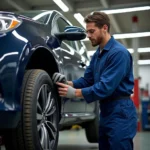Drum brakes – they are still a common sight on the road, even though disc brakes are becoming increasingly popular today. But how exactly does a drum brake work? And why are they still found on the rear axle, even in modern cars?
Imagine driving your classic car, a stylish Mercedes-Benz W123, down a country road. Suddenly, a deer appears on the roadside! Instinctively, you hit the brakes. In that moment, a fascinating spectacle unfolds within your brake drums:
From Brake Pedal to Brake Pad
As soon as you depress the brake pedal, brake fluid is pumped through the brake lines. This fluid reaches the wheel brake cylinder, located inside the drum brake. The pressure from the brake fluid causes two brake shoes, equipped with heat-resistant brake lining material, to press against the inside surface of the brake drum.
Friction is the Key
The friction between the brake linings and the brake drum slows down the rotational movement of the wheel. This process converts kinetic energy into thermal energy, which is dissipated into the surroundings.
“Drum brakes may have a simpler design than disc brakes,” explains Dr. Ing. Hans-Peter Müller from the Institute of Automotive Engineering, “but the principle of friction behind it is just as effective.”
Advantages and Disadvantages of Drum Brakes
Drum brakes have some advantages compared to disc brakes. For example, they are:
- Cheaper to manufacture
- Better protected from dirt and water
- More durable and require less maintenance
However, they also have disadvantages, such as:
- Lower braking performance at high temperatures (fading)
- More difficult to service and repair
- Higher weight compared to disc brakes
Frequently Asked Questions about Drum Brakes
- How often do I need to change the brake fluid for drum brakes?It is recommended to change it every two years or according to manufacturer specifications.
- How do I know if my drum brakes are worn out?Grinding noises when braking, a longer braking distance, or a pulsating brake pedal can be signs of worn drum brakes.
- Can I repair drum brakes myself?Work on the brake system should always be carried out by a professional workshop.
Conclusion: The Drum Brake – A Proven System
Even though disc brakes are becoming more common, drum brakes have not lost their place in automotive manufacturing. Especially on the rear axle, where braking forces are lower, they are convincing due to their durability and cost-effectiveness.
Do you have further questions about drum brakes or other areas of automotive technology? Don’t hesitate to contact us! Our experts at AutoRepairAid are ready to assist you.

